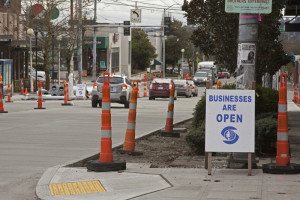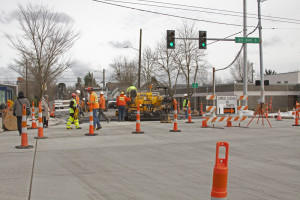Illegal Dumping, CRUEDA Update, and Alki Community Council
Seattle Public Utility’s (SPU) Brand New Approach to Address Illegal dumping
Since 2014, the number of illegal dumping service requests to SPU has jumped from about 5,000 to an astonishing 11,500 in 2015. As a result, unfortunately, the average response time went from 21 days to 28 days. To address this SPU decided they needed to find a way to both 1. Reduce the current service request backlog and 2. Improve future response times.
In order to do that, last week SPU assigned temporary staff to consolidate the backlog of service requests. As of February 18th they had 100% of the backlogged requests reviewed and found that approximately 25% were duplicate requests. This clearly demonstrated a need to address the issue of illegal dumping differently. In other words, SPU shifted from an enforcement model that only responded to complaints, to an enforcement model that also includes proactively clean up illegal dumping in areas where it happens frequently. SPU is now preparing “clean sweep” maps and routes for cleanup crews where they will drive each street to pick up both reported and unreported items – especially in those locations that have frequent illegal dumping activity, so that pick-up opportunities are maximized, the complaint backlog reduced, and response time improved.
Civil Rights, Utilities, Economic Development, and Arts (CRUEDA) Committee Highlights
You may have heard about the Seattle Department of Transportation (SDOT) project on 23rd Avenue and the impacts of this construction on the businesses in the area. Though the problems have only recently come to light at City Hall, the Central District businesses have been dealing with them for many, many months. Businesses that have been around for 20 years, like Earl’s Cuts and Styles barbershop and Flowers Just 4U have seen sales plummet since November and are at risk of closing down. Other businesses have had to delay expansion plans. Since my committee  addresses issues related to economic development – particularly small businesses in our neighborhood business districts – last week I requested that the Office of Economic Development (OED) and SDOT come and brief my committee on how they intended to address these impacts.
addresses issues related to economic development – particularly small businesses in our neighborhood business districts – last week I requested that the Office of Economic Development (OED) and SDOT come and brief my committee on how they intended to address these impacts.
BACKGROUND
The “rechannelization” project is to modify 23rd Ave from a four-lane street to a three-lane street – one lane in each direction with a center left-turn lane, (key intersections will stay four lanes). As with District 1’s own 35th Avenue SW rechannelization project, the turn lane is intended to allow left-turning vehicles to make a safe left turn, while still allowing thru-traffic to continue through an intersection and down the street. Road rechannelization projects are often controversial, but in this case, because of a desire to reduce collisions, to allow vehicles to turn without blocking traffic, and to make streets easier to cross there was relatively little opposition for this project.
A commitment was made to the community that this part of the project would be broken into zones, as a way to reduce impacts by making sure that no more than 2 blocks were under construction at any given time. But all of that changed in November 2015 when a problem arose with the design of the light poles. To keep the project on schedule SDOT decided to start work on the 2nd zone of the project before the 1st zone was completed. Neither OED nor the community was consulted. As one business owner told the Seattle Times, “This project has been a slow squeeze to the point now where we get no car traffic, no bus traffic, no foot traffic, and this isn’t just about me. This is about a corridor of 100 percent minority and family-owned businesses.”
WHAT NOW?
Though the business community had been told previously that there were no funds to assist them beyond some limited marketing services, the day before my CRUEDA committee meeting, the Mayor announced a $650,000 Business Stabilization Fund formed comprised of federal Community Development Block Grant funds and fees from New Market Tax Credits. In my committee we learned more about how those funds would be administered. Eligible businesses are:
- Micro business with 5 or fewer employees; and
- Serve a low-income service area; or
- A low-income business owner, earning less than 80% AMI and
- Has a demonstrated need.
As described in the CRUEDA meeting, funds can be used for operational costs or physical improvements. My concern is that we should ensure the fund pays for all demonstrated business losses associated with the construction before funding physical improvements. 
OED is still formalizing the process but hopes to have it all mapped out by next week. This includes creating a simple intake form that will be accessible online at a website for initial intake that hopefully also will be up by the end of the week.
The first step will be getting businesses to complete the intake form. OED will facilitate 2-3 workshops with the community around the intake and eligibility to obtain mitigation funds. Business owners will have to show loss of revenue since construction started and projected impact through its completion – OED suggested that they should start gathering any documentation to show this.
The preliminary plan is to create an initial cap on the funds to each eligible business, then potentially follow up with additional funding as necessary/demonstrated need by business if there are funds left. The goal is to get the money directly to businesses well before the end of March. The City is also offering Seattle City Light and Seattle Public Utility bill payment deferrals.
SDOT agreed that they must do a better job in engaging businesses and other community members when issues arise like these and answers need to be made in very short time frame. This includes working more closely with OED; in particular on its detour notices that go out to the community. The notice that went out last week for this project read as a “stay away” notice instead of a “come here” and patronize our open businesses.
My Visit to the Alki Community Council
Last Thursday I attended the Alki Community Council meeting. I talked about my committee assignments and answered a broad range of questions.
Much of the discussion there concerned a project proposed for 1250 Alki Avenue SW, for a six-story building with 100 residential units, 150 parking spaces, and 1500 square feet of retail space. The area is a midrise (MR) zone. It would replace several single-family homes on lots from 1250 to 1262 Alki Avenue SW. I learned that the community is asking to be involved in future design discussions; supports a code-compliant option that meets the massing and scale of the neighborhood, and opposes the departures for width and depth being requested; their position is it does not meet the “public benefit” test required for variances. A Second design review board meeting took place in January. More information about the design proposal and permit status can be found here.
Posted: February 24th, 2016 under Councilmember Herbold, Seattle Public Utliities, Transportation
Tags: Alki, SDOT, Seattle Public Utilities

